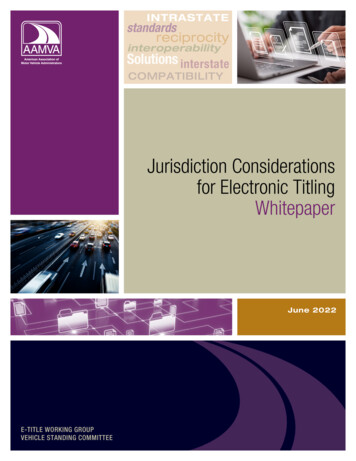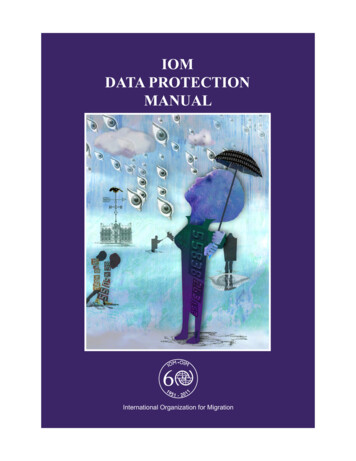
Transcription
tions interstateCOMPATIBILITYJurisdiction Considerationsfor Electronic TitlingWhitepaperJune 2022E-TITLE WORKING GROUPVEHICLE STANDING COMMITTEE
ContentsBackground . . . . . . . . . . . . . . . . . . . . . . . . . . . . . . . . . . . . . . . . . . . . . . . . . . . . . . . . . . . . . . . . . . . . . . . . . . . . 3Jurisdiction Considerations for Electronic Titling. . . . . . . . . . . . . . . . . . . . . . . . . . . . . . . . . . . . . . . . . . . . . . 4Working Group Roster . . . . . . . . . . . . . . . . . . . . . . . . . . . . . . . . . . . . . . . . . . . . . . . . . . . . . . . . . . . . . . . . . . . 92022 Copyright All Rights Reserved American Association of Motor Vehicle AdministratorsCover photos credit: iStockphoto.com2
BackgroundIn November 2021, AAMVA published the ElectronicTitling Framework which identifies and describeselements for electronic titling. The framework focuseson defining what electronic titling solutions areand why jurisdictions need to implement a solutionwith standards, which promote interoperability andreciprocity. This information helps jurisdictionsunderstand the basis of electronic titling, whicheliminates paper processes in favor of electronic recordexchange for all persons and entities involved invehicle titling transactions.This Jurisdiction Considerations for Electronic TitlingWhitepaper provides 15 topics for jurisdictions tocontemplate as they begin or continue their journeytowards implementing electronic titling solutions.These considerations build on the ElectronicTitling Framework by providing information,resources, and questions about the electronic titlingelements identified and described. There is nota specified sequence jurisdictions should followwhen developing action plans. Jurisdictions areencouraged to review the entire document andprioritize action items based on the needs andgoals of the jurisdiction. These considerations arefor both an intrastate jurisdiction solution andfor compatibility with an interstate interoperablesolution and provide a starting point or catalyst forplanning and development.Note: Jurisdictions may encounter additional itemswhich need to be addressed throughout the electronictitling research process that may not be identified in thisdocument.AAMVA anticipates continuing to assist jurisdictionsin moving toward electronic titling solutionsby developing guidance and best practices. Thisinformation will aid progress towards identifyingfunctional needs for electronic titling solutions.Background3
Jurisdiction Considerations for Electronic TitlingPreparationUnderstanding Electronic Titlinga. Have you reviewed AAMVA’s Electronic TitlingFramework?a. An electronic titling solution has multiple elementsthat make up the solution to transition from a papertitling process to an electronic titling process. Anelectronic titling solution aims to facilitate a secureelectronic titling process that no longer relies onphysical paper.1. The Electronic Titling Framework provides abaseline of information for electronic titling andcan be found here. The federal rule OdometerDisclosure Requirements (49 CFR Part 580) setsa minimum identification level of certainty forelectronic odometer disclosures.b. Have you reviewed the National Institute ofStandards and Technology (NIST) standards foridentity proofing and authentication (IAL2 andAAL2) found in NIST Special Publication 800-633, Revision 3, Digital Identity Guidelines (includingparts A, B, and C) with a revision date of June2017?1. The NIST standards are the foundation for therequirements to allow an electronic signature forcompletion of the odometer statement.2. The standard is based on NIST SpecialPublication 800-63-3, Revision 3, DigitalIdentity Guidelines (including parts A, B, andC) with a revision date of June 2017. Additionalinformation and resources for the DigitalIdentity Guidelines can be found on the NISTIdentity and Access Management ResourceCenter4Jurisdiction Considerations for Electronic Titlingb. Electronic Title (e-title) – The electronic record(digital data) of vehicle ownership created andmaintained by a jurisdiction.c. Electronic Title Transfer Process – Secure,electronic method to validate ownership andfacilitate the assignment or reassignment of a vehiclewithout reliance on a paper process.d. Ability to Access Title Information – Electronicmethod for an owner or owner’s designee tosecurely access and view title information recordedon the electronic title for the vehicle. This accesswould be used to provide proof of ownership, ifnecessary.e. Electronic Lien and Title (ELT) and ElectronicVehicle Registration (EVR) or ElectronicRegistration and Title (ERT) Versus ElectronicTitling – The functionality of an ELT and EVR orERT program may be an element of the electronictitling solution. More electronic functionality willbe needed to move to completely paperless titletransactions and a fully electronic titling solution.
E-Titling All Elements of the Titling Transaction are ntsMSO/MCODealer/Private/AuctionSalesInter/Intra StateTransactionsCasualSalesOdometerDisclosureFOUR FOUNDATION “PILLARS”1StandardizedData Set2DefinedIdentificationPolicies(NIST 800-63-3Standard)Legislationa. Do your statutes allow for electronic titletransactions?1. Does the statute(s) mandate the use of anelectronic title system on a specific date?b. Are there requirements for wet signatures or paperapplications that need to be made flexible to allowfor paperless transactions?c. Is there flexibility in charging fees for electronic titletransactions where a paper title is not printed?d. Do you have a definition for an electronic title? Ifso, does it align with the definition of electronictitle in the Electronic Titling Framework?e. Who are the stakeholder groups that may haveinterest in the titling statutes and may haveinfluence in the legislative sdictionalOperationalPoliciesf. Do your statutes, rules, or policies require proofof identity before titling a vehicle? Verifyingidentity before completing a titling transaction is afoundational element of electronic titling, regardlessof whether the transaction involves an odometerdisclosure.g. Jurisdictions should consider the following whendeveloping an electronic titling system:1. Compliance with electronic signaturerequirements set by the National Institute ofStandards and Technology (NIST), Sec. 800.63,level 2 or level 3, as required by 49 CFR Sec.580.3 (“Signature”) (10.2.2019);2. Compliance with the Federal Truth-in-MileageAct (TIMA) and 49 CFR 580;3. Compliance with the Uniform ElectronicTransaction Act (UETA);Jurisdiction Considerations for Electronic Titling5
4. Satisfying functional components that subjectthe parties of the electronic transaction to thejurisdiction’s perjury or fraudulent unsworndeclarations/certifications;5. Ensure the identity of the parties conducting thetransactions are validated; and6. Notification given to the parties of the electronictitle transaction that by using the jurisdiction’selectronic titling system, they are subjectingthemselves to the jurisdiction’s laws.Industry Stakeholdersa. Identify the industry stakeholders in yourjurisdiction who are involved in titling processes(dealers, auctions, financial institutions, insurancecompanies, fleets, etc.)1. Industry stakeholders that would benefit fromelectronic titling2. Industry stakeholders that may have concernsabout electronic titling in relation to theirbusiness model ( i.e., title service companies)b. Work with industry stakeholders to understandtheir business processes and how they use the papertitle (Some accommodations may need to be madefor industry, but they may need to be flexible toaccommodate changes in business practices.)c. What is an industry stakeholder’s fundamentalneed? In what ways is a paper title serving a businessneed? Can the same need be satisfied through anelectronic process?1. Example: Wholesale auctions use the paper titleas collateral because many times they will paythe dealer selling the vehicle before the buyingdealer provides payment. The wholesale auction’sbusiness practice places a hold (stop) on a vehicletransfer between the selling and buying dealerpending payment.6Jurisdiction Considerations for Electronic TitlingJurisdiction Agencies and Entitiesa. Will your agency need to work with otherjurisdiction agencies or authorized entities thatprocess vehicle transactions on behalf of the state? Ifso, who are they?1. Example: Will you need to work with yourjurisdiction’s driver licensing agency?b. What kind of impact will a change to your titlingprocess have on other jurisdiction agencies orentities?c. Will you need to coordinate with third-partyentities who also issue titles?d. How will electronic titling affect third-partyentities?e. What will third parties need to do or change toaccommodate customers using electronic titlingprocesses?Title Transaction Inventorya. Inventory all types of title transfers and titlemanagement actions (adding/removing liens orbrands, etc.) performed in your jurisdictionb. What types of vehicles will be included in theelectronic titling transfer functionality?c. What will prevent a certain type of title transferfrom being completed electronically?d. Does your jurisdiction already complete certaintypes of title transactions electronically? (Example:Electronic Lien and Title)e. How will an owner access and/or share their currenttitle information if a paper title is not issued?f. Will current titling practices need to change toaccommodate a paperless electronic titling system?
g. Does a title transaction affect any otheradministrative actions that your jurisdictioncompletes at the time of title transaction?h. Who are the participants in the various titletransactions? (Example: salvage title transactions—original owner, insurance company, salvage auction,buyer from the auction).i. How will paper titles be accommodated while yourjurisdiction is implementing a fully operationalelectronic titling process?Identity Verification and Managementa. How will your system verify the identity of theseller who is initiating the electronic transfer of avehicle title?System Impact and Developmenta. Will the system be developed by a vendor or withjurisdiction resources?b. Will a request for proposal (RFP) be needed?c. Are existing systems capable of managing increasedworkloads from electronic titling requirements?Fundinga. Will an electronic titling system require additionalsupport staff or a different allocation of staff?b. Is there funding for ongoing system maintenanceand operation?c. Is there a strategy to generate or recover start-up costs?b. How will personal identifying information beprotected?d. What current funding will be impacted by thereduction of printing paper titles?c. Will the system eliminate the unneeded sharing ofpersonal identifying information?e. Are new fees recommended or required tosupport the initial buildout and to provideongoing support for electronic titlingtransactions? If so, will statutory authority beneeded to enact those fees?d. Have you reviewed the NIST standards for identityproofing and authentication? What changes willneed to be made to incorporate those identitymanagement practices?Agency Impact Interoperability BetweenJurisdictionsa. How would the creation of an electronic titlingsystem impact customer flow in offices?a. Has your jurisdiction identified data elements thatare currently used in titling transactions?b. If the use of an electronic titling system is initiated,how will it impact mail-in processing centers and/orEVR programs?b. Will your jurisdiction use a standardized set ofdata elements to enable interoperability betweenjurisdictions?1. The AAMVA E-Title Working Group isidentifying data elements for electronic titlingwhich will be made available in a future WorkingGroup guidance document.c. Will more staff be needed for customer support(example: answering questions, troubleshooting“computer and log-in issues”, etc.)?Internal Communicationa. What is the plan for informing staff of changes andgathering support?b. What training will be provided?Jurisdiction Considerations for Electronic Titling7
Public Education and Outreacha. What education can be provided to legislators andpolicy makers?b. What education can be provided to stakeholders?c. Educating the public will be important, use avariety of resources to provide information, such as:1. WebsiteWhere to Start Development andImplementationa. Start with one type of transaction or functionality.The simpler it is the better.1. Example: ELT, private party sale, or simpledealer saleb. Start with what will work best for your jurisdictionand stakeholders.2. News release3. Videos4. Info graphics/ handouts in office5. Mailing insertsData and Reportsa. Consider plans to incorporate audit and dataanalytical functionality into any electronic titlingelements.b. What data and reports will your jurisdiction needfor business purposes and for fraud detection andmitigation purposes?8Jurisdiction Considerations for Electronic Titling
Working Group MembersMEMBERSClint Thompson, ChairDeputy DirectorTexas Department of Motor VehiclesRalene Whitmer, Vice ChairTitle and Registration SpecialistArizona Department of TransportationNegash AssefaDirector, Information TechnologyMaryland Motor Vehicle AdministrationRepresentative from the Electronic Identity (eID)SubcommitteeJustin BrintonAssistant IT DirectorUtah State Tax CommissionChristopher CharlesDirector of TitlesIndiana Bureau of Motor VehiclesGretchen DaleyCommercial Operations Program CoordinatorMassachusetts Registry of Motor VehiclesIrenata DuncanAttorneyGeorgia Department of RevenueLance EverettChief Data OfficerCalifornia Department of Motor VehiclesKeith JeffersSpecial Investigations ManagerTennessee Department of RevenueJulie LarsenBusiness ArchitectFlorida Department of Highway Safety & Motor VehiclesMadison LumpkinDeputy Administrator, Central OperationsMaryland Motor Vehicle AdministrationPrerna MukhijaAdministrative Analyst 4New Jersey Motor Vehicle CommissionHank RosserIT AnalystVirginia Department of Motor VehiclesScott ShenkDivision Chief for Vehicle RegistrationPennsylvania Driver and Vehicle ServicesTed SmithAttorneyKansas Department of RevenueAAMVA STAFFPaul SteierProject ManagerDirector, Vehicle ProgramsVivienne CameronSenior Director, Business SolutionsMarcy ColemanManager, Vehicle ProgramsRyan KahnDirector, Project ManagementMike McCaskillDirector, Identity ManagementEvgenia TyrsinaLead Business AnalystWorking Group Members9
Identity Guidelines (including parts A, B, and C) with a revision date of June 2017 . Additional information and resources for the Digital Identity Guidelines can be found on the NIST Identity and Access Management Resource Center Understanding Electronic Titling a . An electronic titling solution has multiple elements










